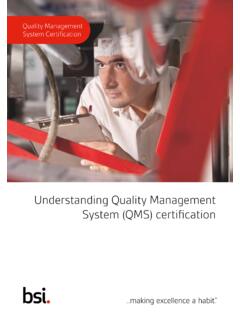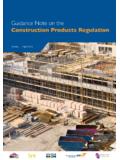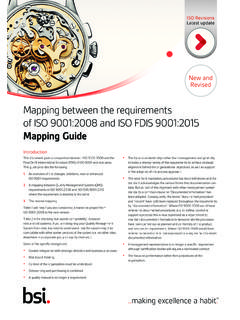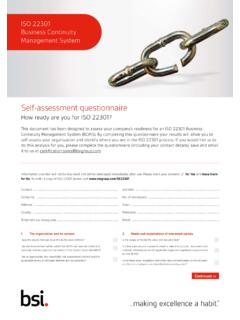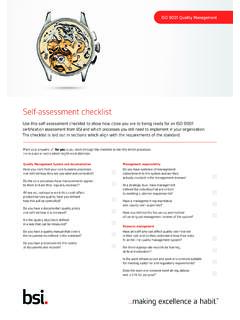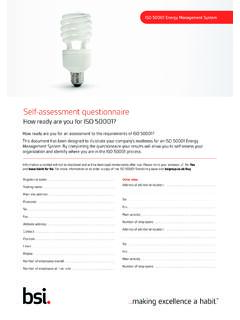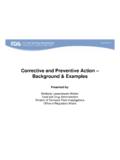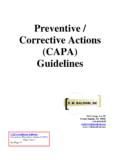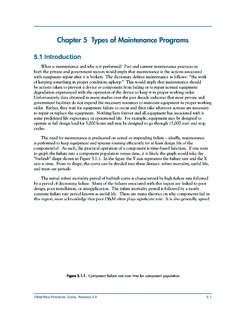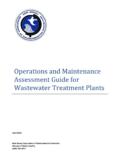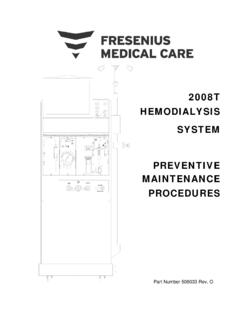Transcription of BSI Corrective and Preventive Actions
1 Corrective action :The closed-loop systemWhite paperContentsSummary 3 How Corrective action works 4 The stepsStep 1 - Identify non-conformities 5 Step 2 - Opening a Corrective action 6 Step 3 - Responding to a Corrective action 7 Step 4 - Defining the root cause 8 Step 5 - Implementing the solution 10 Unleashing the power of Corrective action with a closed-loop system 11 Conclusion 12 The closed-loop systemSummaryThe
2 Corrective action process is a fundamental process that affects all of the control points in a company s management system. Auditors tend to look deeply into companies Corrective action processes during investigations. Key questions typically asked include: Are Corrective Actions followed-up in a timely fashion? Do records prove that all Actions have been completed successfully? Are all recommended changes completed and verified? Was the actual root cause identified? How was it validated? Was action taken to correct or prevent the problem and ensure it will not happen again? Has it been demonstrated that Actions taken have no adverse effects on products or services? Was training performed and communications issued to ensure that all relevant parties understand the situation that occurred and the changes that have been made?
3 Monitor, measure, correctTo better manage the issues that launch the Corrective action process, companies need to optimize their practices by implementing efficient, closed-loop Corrective action processes. Every good Corrective action process should have a built-in audit process to verify and validate that the Corrective action system is at optimal performance. Data and evidence tracking is a critical component of action management as well, so the organization can ensure that all non-conformity information can be confirmed, monitored, measured, and, if necessary, successWith nearly every ISO standard, ISO 9001, ISO 13485, ISO 14001,ISO/IEC 27001, or OHSAS 18001,organizations must determine the actionsthey can take to eliminate the causes ofpotential non-conformities. A company sability to rapidly correct existing problemsand implement controls to prevent potential problems is essential to ensure customer satisfaction and achieve operational success.
4 While a Corrective action process must meet the necessary industry compliancerequirements, it must also be , managers will find themselvesin a constant state of response and thecorrective action process becomes a | Corrective action : the closed-loop system3 How Corrective action worksIt s all about improvementA Preventive action is created to offset a potential problem. While the Preventive action process can contribute to the overall continual improvement effort, its main objective is to eliminate potential problems before they occur. Corrective Actions , on the other hand, provide managers with not only the data they need to construct an effective and efficient Corrective action process, but can be used as input into Preventive Actions . Using both types of Actions enables a company to transform itself from an operation that is continually reacting to failures, to one with the processes in place to prevent problems in the first place.
5 Ultimately, the company saves time and money and, most importantly, retains improvementCorrective Actions are processes that may be used to achieve continual improvement. Continual improvement reflects an ongoing effort to improve products, services, or can be incremental improvement overtime or breakthrough improvement all atonce. For instance, an organization sdelivery processes are constantlymonitored and evaluated in light of thefact that they are already considered to be effective; improvement may come in the form of making the processes more efficient. Improved efficiency could lead toa decrease in administrative and operations costs, thereby lowering the costs of goods and services and providing an opportunity to lower prices to be more competitive and win more that implement a closed-loopcorrective action process can expect to experience satisfying and cost-effective Figure 1 for an illustration of a closed-loop Corrective action process and how it ties in to the Plan, Do, Check, Act (PDCA)process.
6 Through continuous monitoring, issues are highlighted, thereby allowing them to be addressed in real-time. Consequently, the closed-loop process reduces the number and severity of issues that occur. Over time, organizations build an intelligent knowledge base and can implement additional Preventive Actions , thereby being more proactive, further improving processes and operations throughout their facilities. As a result, customer satisfaction improves and the bottom line moves in the right addition to these advantages, a closed-loop Corrective action process ensures that best practices are consistently applied to the processes that support compliance requirements. Properly documented Actions provide managers with important historical data, which may be used to implement continual improvement plans; a well thought-out, integrated process can help in the capture and dissemination of operational intelligence related to these | Corrective action : the closed-loop system4 Maintain and improve the systemRESPONDRECOVERE stablish systemMonitor andrevise the systemDETECTI mplement and operate the systemPREVENTF igure 1.
7 Closed-loop processRequirements and expectationsManaged systemLearnLearnLearnLearnPLANCHECKACTDO I nterested partiesINPUTSI nterested partiesOUTPUTSBSI | Corrective action : the closed-loop system5 Identify non-conformitiesWhen implementing a Corrective action process, it is important to define all of the non-conformities that could impact a company s operations. Having a good grasp of the non-conformities helps managers write procedures and design Actions that will be taken when a Corrective action plan is what is a non-conformity?A non-conformity is defined as a deviation from a specific procedure, standard, statedprocess, or system requirement. Whendefining non-conformities, it is importantto identify the potential severity of theimpact they could have on a managementsystem.
8 For example, a major non-conformity could be an actual orpotential deficiency that will seriouslyaffect the management system. A minorone would be a less serious more isolatedincident, such as a documentation/workinstruction error or of the many issues related to thecorrective action process are: Poor documentation of requirements Failure to document and communicate updates or process improvements following a Corrective action Inability to trace training documents Corrective Actions that are outdated or closed without validation Missing or misplaced data Failure to monitor critical controlsA closed-loop Corrective action process enables companies to avoid or minimize the occurrence of issues, as managers arebetter able to characterize problems andassemble the best possible cross-functionalteam of people to successfully tackle illustrated in Figure 2, BSI ISO 9001field audit results over a twelve monthperiod reveal that the majority ofnon-conformities are raised in the areas of document and record control closelyfollowed by monitoring & measuring.
9 Andimprovement. All three are closely linked,as a good Corrective action system requires good documentation and continuousmonitoring in order to deliver 2. Non-conformities by clause for ISO 9001 & requirementsStep1 Step2 Step3 Step4 Step5 Step 1:BSI | Corrective action : the closed-loop system6 Opening a Corrective actionSome organizations open a Corrective action for every event, regardless of its severity or potential impact. However, this creates bottlenecks because employees become so focused on their Corrective Actions that they find it difficult to focus on their other day-to-day responsibilities. It also creates a feeling of chaos and concern that the sky is falling ; continuous improvement suffers by trying to keep up with Corrective 9001:2008 simply states that whenplanned results are not achieved,appropriate Corrective action shall betaken.
10 It goes on to say that whenmanagers are determining suitableactions, they would be wise to considerthe type and extent of monitoring ormeasurement they plan to undertake. This is similar for many other ISO Actions taken should be appropriateto each process related to the problemand should be considered in relation totheir impact on conformity to productrequirements and the effectiveness of the management system. If the system is monitoring wrong or contaminated data, companies basing Actions and assigning resources to implement those Actions could find themselves wasting resources and riskRisk assessment is a good way to avoidthis effect. Risk matrices* help managersand teams to clearly define risk, severity,and potential impact. They also helpdetermine which procedures, designs, andcontrols best define expected performance.

